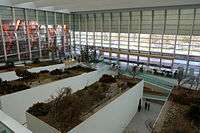Museum of Human Evolution
 | |
| Established | 2010 |
|---|---|
| Location | Burgos, Spain |
| Visitors | 279.000 (July 2010-July 2011) |
| Director | Javier Vicente |
| Website | www.museoevolucionhumana.com |
| Area | 15,000 m2 (160,000 sq ft) |
The Museum of Human Evolution (Spanish: Museo de la Evolución Humana - MEH) is a museum on the subject of human evolution situated on the south bank of the river Arlanzón, in the Spanish city of Burgos. It is located roughly 16 kilometres west of the Sierra de Atapuerca, a UNESCO World Heritage Site and location of some of the most important human fossil finds in the world.
The museum was opened on July 13, 2010, and had received 148,045 visitors as of December 31, 2010, making it the most visited museum in Castile and León.
It forms the centerpiece of the so-called "Complejo de la Evolución Humana" (Human Evolution Compound) comprising a convention centre, the CENIEH research institution and the museum itself .
Architecture
The building, as well as the whole compound, was designed by Spanish award-winning architect Juan Navarro Baldeweg. The land on which it was built was the "solar de Caballería", a large plot of land in central Burgos where once had stood the convent of San Pablo, one of the foremost houses of the Order of Preachers in Castile. After its demise in the mid-19th century, military barracks were built in its place.
The demolition of said barracks in the 20th century left a significant, purposeless void which was being used as a car park; not until 2000 was the decision made to build a museum on human evolution in its place. Navarro was chosen as the architect after an international competition where his design won over others made by Cruz y Ortiz, Steven Holl, Arata Isozaki and Jean Nouvel. Works on the site began in 2005 and are due to finish in 2012, although both the CENIEH and the Museum are already complete as of May, 2011.
The museographic project was designed and executed by the company Empty. The audio visual integrated systems of the museum were implemented and programmed by Sono Tecnologia Audiovisual. The museum includes more than 25 large format projections, 360º circular projection and more than 50 video sources, controlled by an automation system and sycnchronized with special effects.[1]
Structure

The interior landscaping project recreates the scenery of the Sierra de Atapuerca. At the top of the pads create a faithful reproduction of the mountains.
Level -1 is conceived as the heart of the museum. A single exhibition space in which to locate the archaeological and paleontological complex sites of the Sierra de Atapuerca. The visitor can find a reproduction of the Sima de los Huesos as a three dimensional model and didactic. Within the first pill is located Homo antecessor and the sites of the Gran Dolina and Sima del Elefante.
Level 0 is dedicated to the theory of evolution by Charles Darwin and the history of human evolution. This floor is one of the most spectacular points of the museum: 10 ultra-realistic reproductions of human ancestors, made by French sculptor Elisabeth Daynes. The ten prints displayed are for:
- Australopithecus afarensis.
- Australopithecus africanus.
- Paranthropus boisei.
- Homo habilis
- Homo georgicus.
- Homo ergaster.
- Homo antecessor.
- Homo heidelbergensis.
- Homo neanderthalensis.
- Homo rhodesiensis.
Also on this floor is the reproduction of the stern of the famous ship HMS Beagle on which Darwin made his nearly 5-year trip around the world, including his famous stop over in the Galapagos Islands. On this floor the visitor can find the features unique to humans among which stands out the brain.
Level 1 answers, from a functional standpoint, why are so similar to the hunter - gatherer 9000 years ago, and yet so different. Access to the culture floor is by mechanical ramps. On this level the visitor can review different milestones in the evolution of culture.
Level 2 will recreate the three main ecosystems of human evolution: the jungle, savannah and tundra-steppe of the last glaciation
References
- ↑ Sono Tecnologia Audiovisual. "Audio visual integrated systems for Museum of Human Evolution".
External links
Coordinates: 42°20′21″N 3°41′50″W / 42.3392°N 3.6972°W